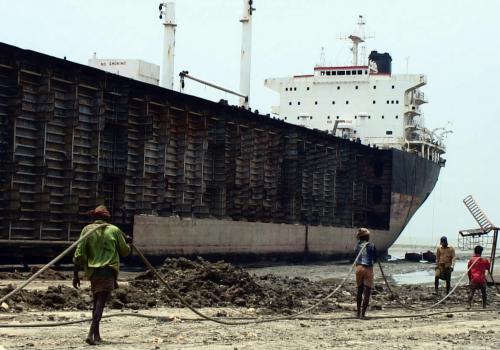UK ferrous scrap exporters are experiencing extremely tight availability of coaster vessels to carry 3,000-5,000t short-sea cargoes to continental Europe because of soaring demand from all bulk commodities seeking to complete shipments prior to the end of the Brexit transition period on 31 December. Intense competition for vessels has pushed the freight rate for coasters on the mainstay UK-Spain short-sea scrap route above €30/t, up from the early €20s/t in late November. Multiple UK short-sea exporters told Argus this week that sourcing a coaster vessel for December shipment had become highly difficult owing to competition from other commodities amid a continued lack of clarity on trading conditions with the EU from 1 January. "We are trying to make a shipment and we are asking where the vessel wants to go — that is all we can do," one exporter said.
UK prime minister Boris Johnson headed to Brussels today for talks with European Commission president Ursula Von der Leyen on a post-Brexit trade deal. Negotiations have stretched out to virtually the last possible moment because of disputes over shared rules and standards to which the UK should follow under any deal, as well as fishing rights in UK waters. The possibility that no trade deal will be struck remains very real, which would see the UK and EU revert to World Trade Organisation (WTO) trading rules on 1 January. Under WTO rules, UK exports to the EU would be subject to tariffs, with the impact likely to fall strongest on the automotive and agricultural sectors. Consequently, there is a rush to complete shipments of commodities potentially subject to tariffs between the EU and UK before the end of the year to avoid any duty in January.
The EU does not currently impose tariffs on ferrous scrap imports from trading partners under WTO rules, and UK scrap exporters told Argus this week that aside from the near-term freight issue, they do not anticipate any significant impact on their business to continental European importers. Sales to the EU will now require additional documentation, but this will largely be the same paperwork currently required for sales to countries outside the EU, in which most UK scrap exporters have experience. Some UK and European traders said there is always the possibility that a failure to agree a trade deal could result in the EU imposing tariffs on imports of ferrous scrap from the EU along with other commodities not currently covered by their WTO trading status, which is adding some urgency to get scrap sales to Europe done by the end of this month. But a larger incentive for UK exporters to sell to Europe right now is the high prices currently on offer and the desire to lock in profit before year end. The price for HMS 1/2 cif Ghent was heard at €270/t this week, in line with the Argus weekly assessment for HMS 1/2 delivered to Amsterdam-Rotterdam-Antwerp-Ghent (ARAG) docks, which rose to €265-270/t this week.
UK short-sea sellers have prioritised selling to ARAG deep-sea scrap exporters over Spanish steelmakers in the past two months because of higher prices on offer and lower freight. The rate for a 3,000t coaster vessel from the UK to ARAG was heard at €21-22/t today, around €10/t lower than Spain. With this freight differential, current Spanish prices at €270/t cif Spain for 1/2 cannot compete with ARAG offers. The shift in short-sea flows exacerbates a wider downtrend in UK scrap sales to Spain, which was formerly its third-largest export destination. UK exports to Spain fell by 39.5pc on the year in January-September to 360,448t. While this decrease was partially caused by the fall in Spanish demand amid the Covid-19 pandemic, it simply accelerated a decline that has been continuing over the past five years. The 360,448t exported from the UK to Spain in the first nine months of 2020 was almost a third of the 960,435t sold over the same period in 2015. The change has occurred as UK scrap formerly sold into nearby markets has increasingly been redirected into the more lucrative deep-sea bulk markets of Turkey and Egypt, and the container markets of south Asia.
